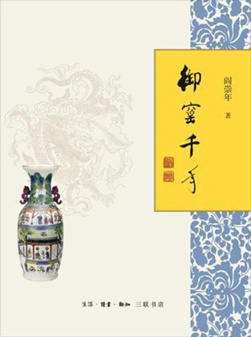
. > WHAT'S NEW > BOOKS
Evolution of imperial kilns, porcelain
Author : ZHANG LONG Source : Chinese Social Sciences Today 2017-08-07

A Thousand Years of Imperial Kilns
Author: Yan Chongnian
Publisher: SDX Joint Publishing Company
Porcelain is familiar to all Chinese people, but most do not know the history of porcelain in great detail. An indispensable part of Chinese culture, porcelain has thousands of years of history that is worth investigating. The book A Thousand Years of Imperial Kilns by Yan Chongnian is a brief cultural history of porcelain that elaborates on the evolution of imperial kilns from the Song Dynasty to the Qing Dynasty. It records the most influential porcelain works produced in the imperial kilns, which were included in the most archives and preserved in museums at home and abroad.
In contrast to other history books on porcelain that mainly focus on the porcelain itself, its production and development, and the raw materials and technology of porcelain making, the book concentrates on people’s role in the development of porcelain. The nearly 400 people introduced in the book include emperors, officials, craftsmen, literati, painters and the eunuchs who guided porcelain production and made policy for the industry, while also supervising the development of the imperial kilns. Their stories breathe life into the history of imperial porcelain.
Porcelain produced in imperial kilns was among the best porcelain produced at that period. By combing through historical materials and observing famous porcelain in past dynasties, Yan brings forth an important clue in the development of Chinese porcelain: the essence of Chinese porcelain is innovation in ideas, management, skills and production. The bluish-white glaze in the Song Dynasty is characterized by its sky-blue color, mirror-like brightness, paper-like thin shape, and chiming stone-like sound when struck. The blue and white porcelain type along with the red glaze of the Yuan Dynasty began a new era for varied colors glazed on the same pieces porcelain. The clashing-colored and five-colored porcelain in the Ming Dynasty added more colors and the enamels and famille-rose porcelain in the Qing Dynasty presented even richer colors in paintings. Innovation was the motivation for the development of Chinese porcelain and also drove the vitality of porcelain culture.
In the book, apart from the main thread that illustrates the rise and fall of the porcelain industry, the other line that links together this work is the innovative spirit in the minds of the emperors, officials and craftsmen.
An expert in the history of Qing and Ming dynasties, Yan spent five years on the book. He learned about porcelain while exploring historical trends. He also travelled to historical sites of porcelain crafting and brought them to the readers. Yan systematically combed through the academic history of naming blue and white porcelain items in the Yuan Dynasty, and pointed out that the meaning of “lang” in the “lang kilns” was the surname of Lang Tingji rather than Lang Tingzuo.
In addition, Yan investigated some key questions on the history of Chinese porcelain production. He revealed contributions of porcelain to cultural exchanges between China and the West, believing that the “porcelain route” that existed along with the Silk Road was also a piece of historical evidence for the East-West cultural communication.
Ye Shengtao made Chinese fairy tales from a wilderness
Ye Shengtao (1894–1988) created the first collection of fairy tales in the history of Chinese children’s literature...
-
How northern ethnicities integrated into Chinese nation
2023-09-18
-
Mogao caves
2023-09-12
-
Mogao Grottoes as ‘a place of pilgrimage’
2023-09-12
-
Time-honored architectural traditions in China
2023-08-29
-
Disentangling the civilizational evolution of China
2023-08-28
-
AI ethics in science fiction
2023-08-23













 2011-2013 by www.cssn.cn. All Rights Reserved
2011-2013 by www.cssn.cn. All Rights Reserved